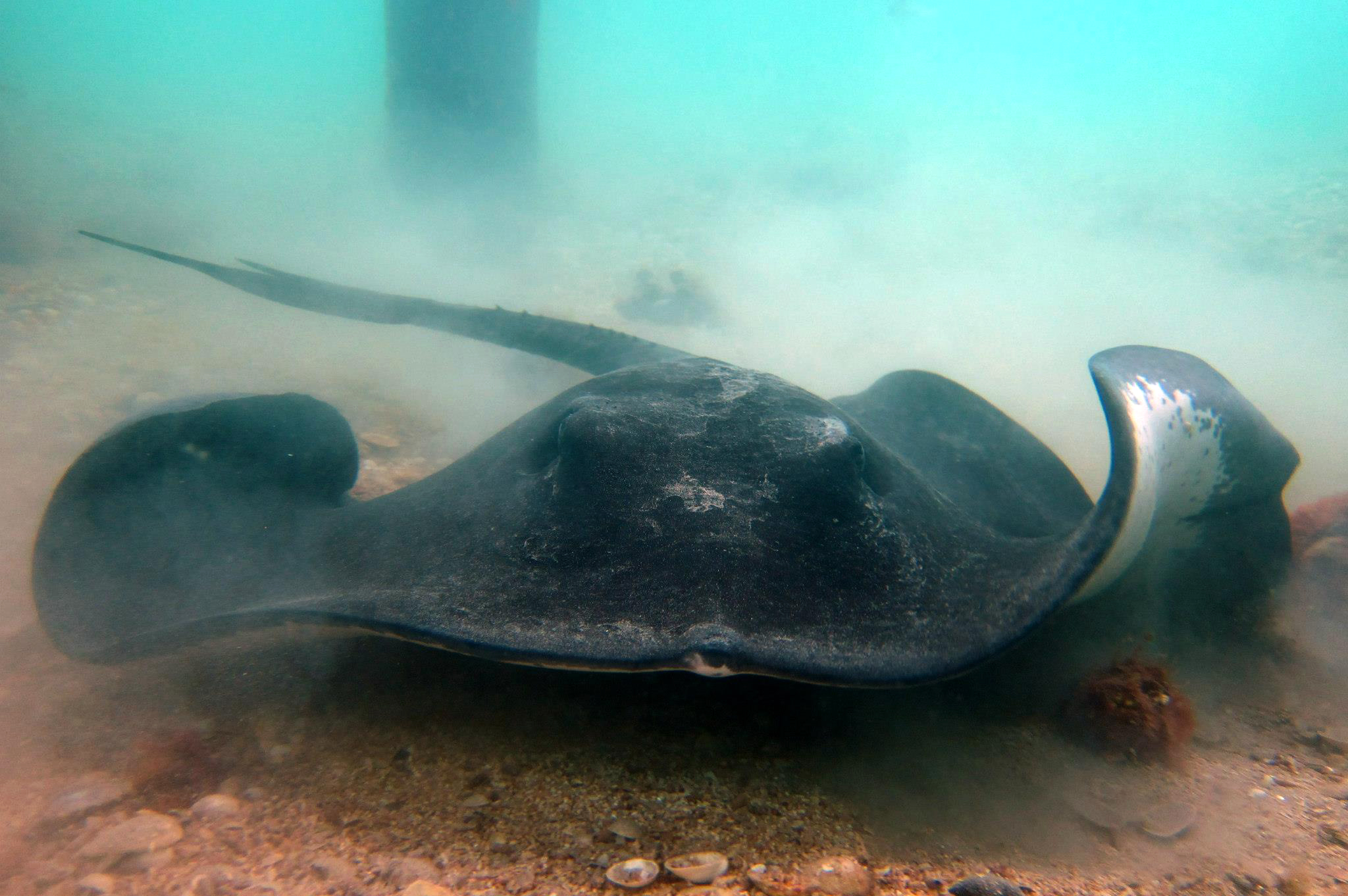- Classification
- CHONDRICHTHYES
- MYLIOBATIFORMES
- DASYATIDAE
- Bathytoshia
- brevicaudata
Smooth Stingray, Bathytoshia brevicaudata (Hutton 1875)

A Smooth Stingray, Bathytoshia brevicaudata, at Blairgowrie Marina, Port Phillip, Victoria. Source: Sarah Speight / Flickr. License: CC BY Attribution-Noncommercial-ShareAlike
An enormous stingray with a deep smooth rhomboidal disc, diagonal rows of pale pores on each side of the head, a short depressed tail tapering towards the sharp finely serrated spine, and a shallow w-shaped groove on the underside just behind the gill openings. The tail is armed with large tubercles and thorns, and lacks a dorsal fin. The Smooth Stingray is greyish-brown above, with a pale underside, and somewhat darker pigment above the eye and on the tail tip.
The large serrated spine on the tail is venomous, and is used for defence. Smooth Stingrays are potentially very dangerous to humans due to their large size, and have been responsible for very painful injuries and at least one death in Australia.
This species was previously known as Dasyatis brevicaudata.
Video of a Smooth Stingray feeding on spider crabs in Port Phillip, Victoria.
Video of a Smooth Stingray at North Head, Sydney, New South Wales.
Video of a Smooth Stingray at Magic Point, Sydney, New South Wales.
Video of a Smooth Stingray feeding at Flinders Pier, Westernport, Victoria.
An albino Smooth Stingray at Walpole, Western Australia.
Smooth Stingrays at Tathra Wharf, New South Wales (along with Mados, Yellowtail Scads, and Trevally).
Smooth Stingray, Bathytoshia brevicaudata (Hutton 1875)
More Info
|
Distribution |
Widespread in temperate waters of southern Australia, from about Maroochydore in southern Queensland, to Shark Bay, Western Australia, including Tasmania. Elsewhere, the species occurs in South Africa and New Zealand. Smooth Stingrays inhabit silty or sandy areas in harbours, shallow coastal bays, estuaries, large inlets, coastal reefs and offshore islands. Individuals sometimes congregate in caves and under large overhangs. |
|
Features |
Disc broad and rhombic, belly with transverse groove, disc width about 1.1-1.2 times length; tail short, tapering strongly before spine, thorns when present are confined to tail before spine. Trunk very thick; pectoral-fin apex narrowly-rounded; snout short, obtuse, with tip barely extended and anterior margins weakly convex; eye small with orbit length and spiracle 2.0-2.2 in snout length; interorbital space broad, up to 4 times orbit length in adults; mouth often with 5-7 oral papillae, deep labial furrows, weakly convex lower jaw; nasal curtain very broadly skirt-shaped, with fringed margin; nostrils oval, oblique. Skin smooth, dermal denticles absent; individuals > 45 cm DW with row of spear-shaped or starry-based thorns and tubercles on mid-line of tail before spine; tail beyond spine covered with sharp thornlets. Tail very broad, depressed at the base, often shorter that disc width, often with one spine; ventral fold short, prominent (extending to just beyond spine tip), dorsal fold reduced to a hard ridge. Pelvic fins rather small with narrowly-rounded apices. |
|
Size |
Maximum total length (TL): 4.3 m |
|
Colour |
Upper surface uniformly greyish brown, darkest on tail tip and above the eye; disc white ventrally; disc margin and undersurface of tail dusky; inside of spiracles white, pores around side of head and diagonal row of pores on each side of anterior disc white; pectoral fin with oblique rows of white spots dorsally. |
|
Feeding |
Feeds on bottom-dwelling fishes, crustaceans and bivalve molluscs, which are often dug up from the sediment. |
|
Biology |
Little is known of the biology of this species. Smooth Stingrays are aplacental viviparous, and females produce litters of 6-10 young, born at about 36 cm DW (disc width). |
|
Fisheries |
Taken as bycatch in inshore trawl, Danish seine, snapper longline and purse seine fisheries. Also taken by recreational line fishers, and on set lines, drag nets and set nets. Individuals without tails are often seen by divers, suggesting that they often survive capture and tail removal by fishers. |
|
Conservation |
IUCN Red List : Least Concern The species is taken in a variety of commercial fisheries throughout its range, and usually released or discarded. |
|
Similar Species |
The similar Black Stingray, Bathytoshia lata, differs in having thorn-like denticles along the dorsal midline of the disc, and lacks white spots. B. lata was previously called Dasyatis thetidis. |
|
Etymology |
The specific name brevicaudata is from the Latin brevis (= short) and cauda (= tail) in reference to the relatively short tail of this species. |
|
Species Citation |
Trygon brevicaudatus Hutton, 1875, Ann. Mag. Nat. Hist. 4 16(41): 317. Type locality: Dunedin Harbour, New Zealand |
|
Author |
Bray, D.J. 2021 |
|
Resources |









